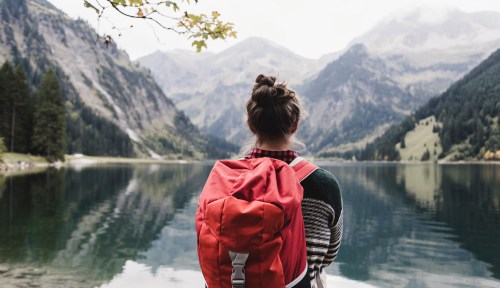How To Pick the Right Hike for You, According to an Adventurist
Want to get out and trek in 2022? Here's how to pick a hike, according to an adventurist who does it all the time.

Adding “hike more” to your list of 2022 goals? Before you set out on a scenic trek, make sure you know if the adventure ahead is right for you. Avid hiker and backpacker Betsy Hawkins spends her summers exploring the rugged and breathtaking seemingly endless trails surrounding her home in the Teton Mountain Range outside of Jackson, Wyoming. And while Hawkins is no stranger to the trail, each excursion still takes ample research to know if the plan meets both her ability and her expectation.
1. Do your research
It’s not all scenic strolls and stellar selfies—although we never turn down a good photo op! First, Hawkins decides what she wants out of her hikes like duration, difficulty, and her current fitness level. Then, she dives into the research. “One of the most important things is understanding elevation gain in relation to total miles,” she says. “A gain of 1,000 feet over ten miles is no biggie and is a pretty flat hike. But 1,000 feet in one-and-a-half miles? Now that’s a very steep, strenuous hike.”
Dig into reviews and write-ups from other hikers in regional trail guides and online trail reviews. It’s a great starting point and gives important first-person insight.
2. Communicate your plans
Before you even begin, have an honest check in with yourself and anyone in your hiking party about ability and expectation. “Anytime exploring on the trails is not without its own inherent risks,” Hawkins says. If you’re hiking while on vacation, plan to start with an easy trail to get a feel for the altitude and overall conditions before attempting something a bit more challenging. More tips for a safe day: “Always hike with a friend and share your route and expected return with friends or family.”
3. Get the Gear
Make sure you are properly equipped to set out. No daypack? Choose a shorter route that might just require a water bottle and snack on hand. “I feel confident going on an easy hike that is relatively flat and less than two or three miles with minimal extra gear, but anything over that, I gear up,” Hawkins says. While these metrics change depending on the heat, exposure, and difficulty, prepare to have at least one liter of water for every two hours you’re gone. Hawkins brings a backpack with a potable water filter, snacks, and extra layers. Particularly in the mountains, you never know when an afternoon rain (or even a snowstorm!) might catch you off guard.
And when in doubt, seek out resources. Visit your local forest service office or hit up a gear outfitter armed with knowledgeable locals.
Oh hi! You look like someone who loves free workouts, discounts for cutting-edge wellness brands, and exclusive Well+Good content. Sign up for Well+, our online community of wellness insiders, and unlock your rewards instantly.
Sign Up for Our Daily Newsletter
Get all the latest in wellness, trends, food, fitness, beauty, and more delivered right to your inbox.
Got it, you've been added to our email list.










